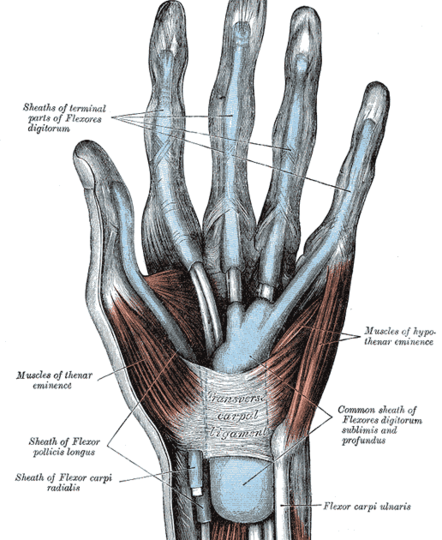
One of the most common side-effects of flexor tendon laceration or injury left unchecked is sheath retraction. This is a phenomenon wherein the flexor sheath pulls back and becomes inoperable, rendering your tendon more difficult to repair.
But what is the flexor sheath? What purpose does it serve, and how does a failure in your tendon sheath affect your finger mobility? Join us today, as we put flexor sheaths under the microscope, with Toby Orthopaedics.
What Are Flexor Sheaths?
Also known as the common synovial sheath, the flexor sheath for the flexor tendons or the ulnar bursa is located in the carpal tunnel of the hand. It is, for all intents and purposes, the highway down which the tendons in your hand travel.
Within this sheath are contained the tendons for the flexor digitorum superficialis and the flexor digitorum profundus flexor muscles. The flexor pollicis longus, responsible for the flexion of the thumb, is not found in this area. It is, however, contained within its own sheath.
The sheath surrounding the flexores digitorum extends downward, roughly halfway along the length of the metacarpal bones. From here, it ends in blind diverticula around the index, middle, and ring finger tendons. This synovial sheath prolongs on the little finger’s tendons, communicating directly with the mucous sheath associated with these tendons.
The flexor tendons are known for their purpose: a system that pulls and releases finger muscles for movement. These tendons pull on the muscles they are attached to. Much like a puppet, this pulling allows the bones to move along their joint axis.
What Do Flexor Sheaths Do?
But these tendons don’t run plainly throughout the body – they have to be contained, or they would rub up against your muscles and eventually wear out (not to mention cause pain). They run part of their course through tunnels known as flexor tendon sheaths, which exist for two reasons:
- They lubricate the tendons running through them, allowing for smooth gliding as the tendon pulls taught and slackens off. This kind of movement, though imitated elsewhere in the body, is at its most dextrous by far in the fingers. This is why we can carry out nimble, quick movements with these, the kinds which our legs or arms would take much longer to complete. Because your fingers are constantly moving, and their movements have to be dextrous, smooth motion is essential.
- Flexor sheaths prevent your tendons from bowstringing. This is what they go through when they aren’t close to the bone. If you bent your wrist back, for instance, the tendon would pull in a straight line instead of snaking along the length of your hand and arm. Pulled tendons of this sort would get in the way and make basic movements far more difficult.
The Toby Orthopaedic Flexor Tendon Sheath Retractor and Suture Retriever/Sheath Dilator is our contribution to the often-complicated world of sheath repair. For more on this product as well as the rest of our product line, visit our website or get in touch today!

